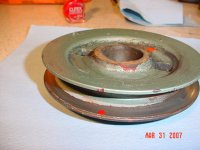RandallRK
Member
Offline
Could someone help me out by showing me what the timing 'notch' should like like on the crank pulley?
I've been avidly following the posts about setting up a Pertronix unit as I just put one on my BN1. It's all set up and engine is running OK but I want to fine tune the timing. However I cannot, for the life of me, find the timing notch which should be there on the crank pulley. The arrow is no problem to see but I'm lost as to where the notch is.
Also- which cylinder is #1- meaning front/rear of engine. I've tried to look it up but can't seem to find out.
Thanks so much!
RK
I've been avidly following the posts about setting up a Pertronix unit as I just put one on my BN1. It's all set up and engine is running OK but I want to fine tune the timing. However I cannot, for the life of me, find the timing notch which should be there on the crank pulley. The arrow is no problem to see but I'm lost as to where the notch is.
Also- which cylinder is #1- meaning front/rear of engine. I've tried to look it up but can't seem to find out.
Thanks so much!
RK

 Hi Guest!
Hi Guest!

 smilie in place of the real @
smilie in place of the real @
 Pretty Please - add it to our Events forum(s) and add to the calendar! >>
Pretty Please - add it to our Events forum(s) and add to the calendar! >> 

